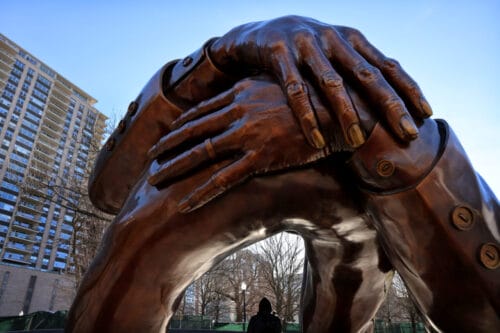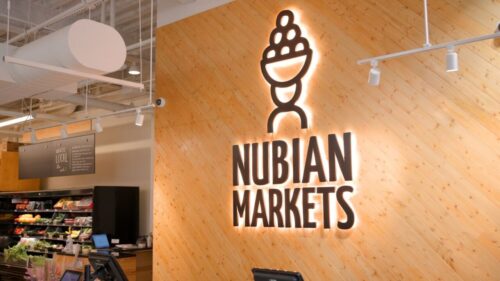
Media News Group, Boston Herald, Getty Images
Communities have long had the answers to feeding themselves. It's time for anchor institutions to listen and bolster their home-grown efforts.
Food access has long been discussed in connection with under-resourced communities — “food deserts,” “food swamps,” and “food insecurity” have become common parlances, especially among food access advocates. But panelists at this fall’s National Community Leadership Summit , hosted by the Vital Village Networks (VVN), a community engagement network embedded in the Boston Medical Center Health System — believe something key is missing from this perspective. While experts acknowledged the reality of challenges that residents in underserved areas face, they emphasized that people living in historically disinvested communities have always been innovative in finding ways to feed each other, creating community gardens and other inventive endeavors geared toward mutual aid.
But as the COVID-19 pandemic wages on, and the sharp downturn in the economy lingers, more and more people are grappling with food insecurity. So, HealthCity talked with program manager Diana Austria Rivera, MSW, MPH, who leads the Community Food Systems Fellowship program at Vital Village Networks, to dig a little deeper on food systems, community, and how the healthcare system can bolster work happening at the local level at this critical time.
HealthCity: What is one of the biggest problems with the current way that our food system operates?
Diana Austria Rivera, MSW, MPH: One of the biggest challenges relating to wellbeing is that the food system is not structured to center people’s dignity and agency. In an ideal world, people should have access to affordable food that is life-nourishing and reflects their cultural traditions.
One of the challenges with the food system and how it operates is that it is structured in a way that isn’t allowing a lot of community ownership. It is very important to Vital Village and the work that we do to lift up local efforts that support folks to have a dignified livelihood and experience across the food system — if you’re a food chain worker, or a parent or caregiver wanting to provide your child a healthy meal, or going to the grocery store — seeing food that represents your culture, that is affordable and accessible matters.
HC: The terms “food desert” and “food swamp” are used a lot in connection to food sovereignty and food justice. What are your reaction to those terms — do they accurately describe the current state of the food system?
DAR: “Food desert” and “food swamp” emerged to help us recognize that it is by design that many low-income communities and communities of color are bereft of healthy food and flooded with fast food, as opposed to healthy, accessible, affordable means to get food.
Many food justice leaders have advocated to use the term “food apartheid” instead. This encourages us to think about the relationship between land, space, neighborhood, community, and food, how those things are interconnected, and the root cause. It acknowledges these realities are not natural forces — they are intentionally designed through policies that have led to redlining and the segregation of people, and, with them, life-nourishing community resources.
The language of food apartheid, food swamps, and food deserts have shone a light on the racial and structural inequities that impact food access. But one of the things those of us in the food justice and health equity spaces are trying to figure out is how we talk about food access from a place that acknowledges the history and structural inequities while also is anchored in existing community strength and abundance.
One of the biggest challenges relating to wellbeing is that the food system is not structured to center people’s dignity and agency. In an ideal world, people should have access to affordable food that is life-nourishing and reflects their cultural traditions.
There’s a lot of ways that these communities are already figuring out how to feed their neighbors and their families in really innovative ways, including community farms and more — despite the systems and structures that are stacked up against them. I don’t discount that the system is broken, but it’s important to shift our thinking and acknowledge community-led social transformation, lifting up bright spots or innovations that’re happening already. And how do anchor institutions like BMC then invest resources in those efforts, support those leaders to scale up those solutions, and learn from them?
HC: What are some community-driven initiatives in the food justice space that you’re excited about right now?
DAR: I’ve had the privilege to learn from a group of Vital Village’s 14 amazing community food systems fellows across the country, who are at that nexus of trying to bridge large institutions, policy practice, and grassroots community-led initiatives to make some real impact around food access, hunger, and shifting ownership of community systems.
One example is the work of Pantaleon Florez III, a farmer, educator, and agricultural researcher whose farm is called Maseualkualli Farms, which means The Peoples’ Farms in Nahuatl. He’s been leading a campaign called Food as a Public Work in the Douglas County, Lawrence, Kansas region, calling upon local government, cities, and counties to create a department embedded within local government focused on the production of food and feeding residents. He makes the argument that if we have a department of public works or housing, we should have a public investment in food systems. He’s asking the question: “What if a city or county could invest in not just providing benefits or food access programs, but actually invest in the production of food itself?” This would mean local government funding the hiring of farmers and ensuring the food that’s produced through public dollars is distributed to folks who face the greatest amount of hunger and in food insecurity.
Another example is Nakia Sims, who is a leader in her public housing community in Houston, Texas. She leads a number of important initiatives, including her advocacy work to mobilize public housing authority institutions to allow residents to have greater access to community garden space to plant as a source of food, healing, and nourishment for residents near public housing facilities, as well as organizing fellow residents and youth across a range of health, housing, and food access initiatives.
HC: What are ways that powerful institutions, like a health system, can work to uplift some of this community-driven work?
DAR: The food system is one avenue where a lot of institutions, especially health-serving institutions, can make strong impact in terms of investment and economic opportunities for folks across the food system. In my work with Vital Village Networks at Boston Medical Center, I’ve been grateful to be able to work with other community leaders in other locations across the country.
Health care institutions like BMC comprise more than just healthcare providers — they employ local people who are embedded in the communities they serve. They provide pathways for education and employment for residents. Institutions can think broadly about the full scope of their relationship to a place and a community and the ways in which their practices have ripple effects and can be leveraged to support greater, more equitable impact, economically, health-wise, and environmentally. BMC has made strides in thinking about sourcing food, particularly with its amazing rooftop garden and food pantry.
Health systems can think more holistically about their own medical services around social determinants of health as it relates to food, in addition to medical interventions. There are a lot of opportunities for institutions to elevate that work by being thoughtful about the decision-makers that help drive policies and practices around procurement or business operations. Are those advisors reflective of their local community? If not, what are ways to create more seats at the table for community residents? How can grassroots leaders who are leading food gardens or urban gardens in Boston be part of the core leadership decision-making structure of these large institutions? For example, Vital Village Networks worked with a group of community leaders who led a grassroots effort that helped launch the Abundance app, an interactive mapping resource that connects residents to a range of local food resources in their neighborhoods.
HC: As institutions work toward this goal, how do we fill in the gaps for people who are experiencing food insecurity?
DAR: When a physician tells a patient, “You need to eat more fruits and vegetables,” and that person lives in an environment that doesn’t allow affordable, dignified access, it can reiterate a sense of guilt and shame about their health condition or behaviors, instead of addressing larger structural barriers.
Food is an important coping strategy — I use it myself. It is important for anyone interacting with a patient to validate that food is a source of health and nourishment, and it could also be a way find comfort when a person is dealing with violence, stress, and trauma. A lot of food educators overstep that piece and immediately present the food pyramid to people. I am proud to know many community-based nutrition educators through our program and partners who really strive to meet folks where they are and focus on a more relationship-driven approach to food education. It’s a powerful experience for to support someone make different connections to food by showing them different options for how to cook or make simple swaps for more accessible ingredients or share new ideas to use ingredients that reflect a culture or food tradition that brings them joy. It goes back to dignity and agency, and the role we each play, in both small interactions or large, more upstream approaches, to center this in the food system.
This interview has been edited and condensed for clarity and length.


